How do you go about leash training an adult dog? That’s the question asked by many dog owners who’ve adopted a dog from a rescue center or shelter.
It’s definitely no fun being dragged to the park or around your neighborhood by your furry friend. You can even suffer from shoulder injuries if you have a really hard puller. So, to save your sanity, we’ve put together this guide on how to leash-train an older dog.
Keep reading to learn how to train an older dog to walk on a leash!
Leash Training an Adult Dog – Tips and Tricks
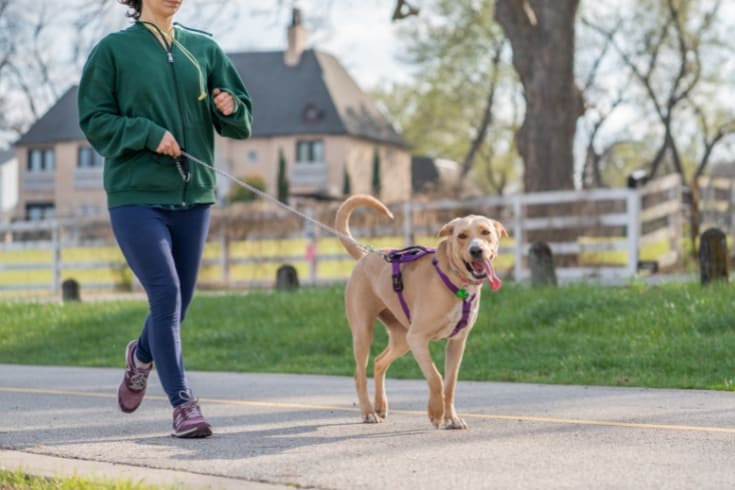
If you’ve adopted an older dog from a shelter or rescue center, good for you!
Older dogs can be just as much fun and are just as loving as puppies, and by taking a pup from a shelter, you’ve given the lucky pup a brand new start in life. However, there are challenges associated with owning an older dog, and leash training is often one of them.
Unfortunately, bad habits, such as pulling, lunging, biting the leash, and jumping up, can be ingrained in an older dog, making them difficult to break. However, if you’re consistent and patient, you can have your adult pup trotting calmly alongside you on his leash within just a few weeks if you follow the tips below.
Before You Start …
Before you begin training your dog, we recommend that you collect everything you’re going to need, including:
- High-value doggie treats
- A correctly-fitting harness
- A training leash
You’ll also need endless optimism and an unlimited supply of patience!
Finding a quiet space where you can train your dog without being distracted or disturbed is also a good idea.
You can use pre-made treats to reward your dog or buy a pack of his preferred treats. Dogs are usually highly motivated by food, so by using your pup’s favorite treats during leash walks, you can keep his attention around distractions and maintain his focus on you.
Training Collars
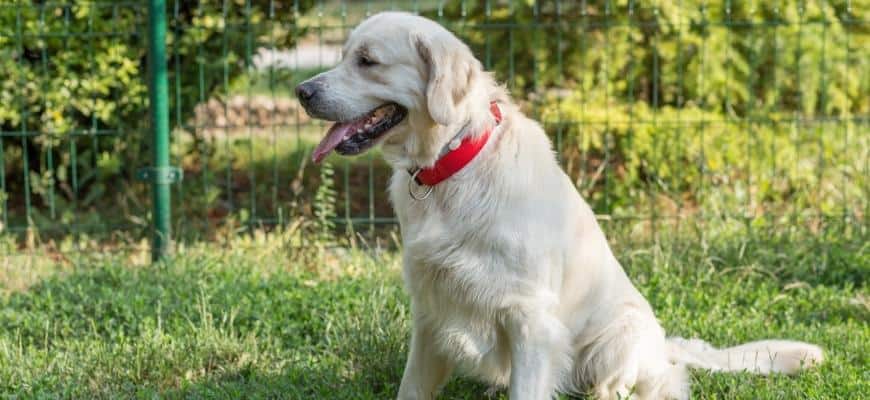
Before moving on to discuss the different training methods you can use to teach your dog to walk on his leash, I’d like to touch briefly on training leashes and training collars.
Training Leashes
A training leash is shorter than a regular leash and can be helpful when tackling bad behavior in older dogs.
Training leads or slip leads look just like regular leashes but have a small metal loop or ring at one end. The idea of a training leash is that you can pull the leash cord through the metal ring to make a larger loop that you slip around the dog’s neck.
A training leash should be used in conjunction with a short regular leash that’s attached to the dog’s harness rather than the collar. If the dog pulls and you need more control over your pup, you can pick up the training leash.
Training Collars
There are several varieties of training collars:
- Prong collars
- Martingale collars
- Choke chains
- Electric shock collars
- Head collars
These types of collars use pain to control the dog. Therefore, we do not consider that any of these devices should be used in the training process.
If your dog experiences pain while he’s on his leash, he might begin to associate being on the leash or even you with a painful, unpleasant experience that he doesn’t want to repeat. A frightened dog can become aggressive, and that’s absolutely not what you want to achieve.
So, punishment-based training techniques are not something we want to encourage, as they are distressing for the dog and rarely successful in the long term.
Verbal Cues
Regardless of the type of leash you use, leash training and basic obedience training will be much easier if you teach your dog a few simple verbal cues.
My older dog came from a rescue center, and although she knew her name, she didn’t understand many other verbal cues. Most dogs are pretty intelligent and can quickly pick up simple words, such as “wait,” “stop,” “heel,” etc.
Keep the words you use short, clear, and simple so that your dog can easily learn and remember them.
Training Methods
There are several widely-used leash training methods:
- The leash training method
- The 180-degree method
- The heel method
All these methods can be used to teach your older dog to walk obediently and calmly on his leash, provided you use consistent training methods. The method you choose is entirely up to you.
Leash Training Method
Here’s how to leash train your dog using the leash training method.
Use a small room in your home where you won’t be disturbed and where there’s nothing outside that your dog can see that might distract him.
Step 1 – Swap Your Leash
If you decide to use the leash training method, you’ll need to swap your regular leash for a training leash. A shorter leash will allow you to correct undesirable behavior quickly and effectively.
Step 2 – Calm Down!
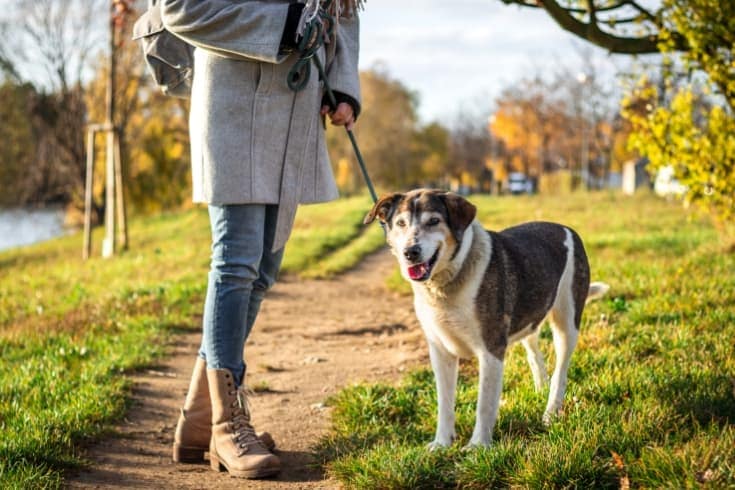
Many older dogs become overexcited and uncontrollable as soon as they are put on the leash, simply because the pup associates the leash with going out for a walk.
So, give your dog a good run or a game in your backyard before you begin leash training him. That way, your dog will burn off his excess energy, making behavioral training much easier.
Spend around 15 minutes leash training your dog in your quiet space so that he learns to dissociate the leash with an exciting walk.
Step 3 – Don’t Pull!
Take your dog out of the door as if you’re going to take him for a walk. If your dog immediately starts attempting to drag you down the garden path, stop, turn around, and go back inside your house.
Keep repeating that until your dog is bored, and you can leave your home without your furry friend going ballistic.
Step 4 – Stop!
The moment your dog starts to pull or lunge, stop immediately and don’t take a single step until he calms down.
This is where your patience comes in, as you could find it takes you forever to get anywhere. However, consistent training is the key to success, so you must persevere!
Step 5 – Reward-Based Training
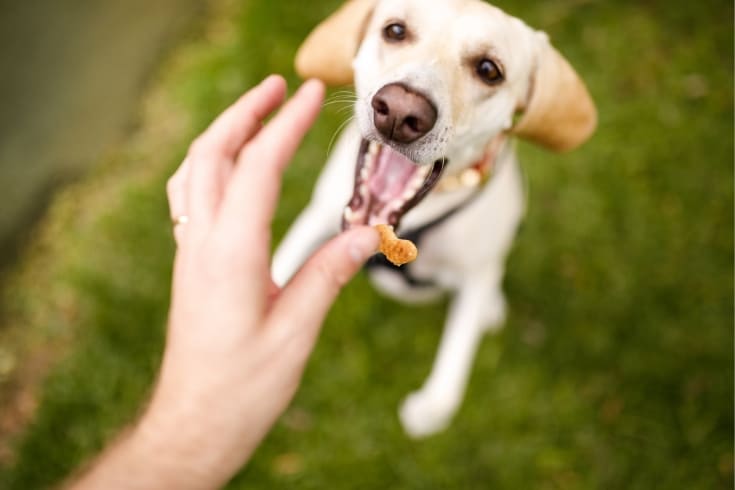
One very important aspect of your daily training is rewarding your dog when he does as you wish, especially throughout extended training sessions.
Your dog needs to know when he’s done what you want and walks calmly beside you. If he remains calm and walks obediently, he’ll get a treat reward. You can speed up the leash training process by offering your dog a treat whenever he travels any distance with you.
The 180-Degree Method
The 180-leash training method is the second most effective leash training technique that’s in use today.
Step 1 – Get Ready!
Start by attaching your dog to his regular leash.
Open your front door and take your dog outside to begin the walk.
Step 2 – Wait For It!
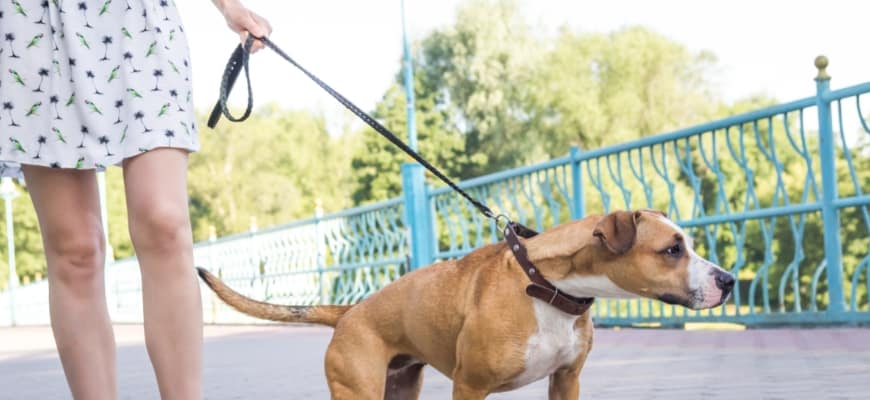
Hold your dog’s leash firmly and wait for him to pull or lunge forward. The idea of this training method is to wait for your dog to misbehave so that you can correct him immediately.
Step 3 – Turn Through 180 Degrees
As soon as your dog pulls, stop, turn right around, and start walking in the opposite direction.
That abrupt 180-degree turn tells your dog that if he starts pulling or lunging, he won’t be allowed to go in the direction he wants to head in.
Step 3 – Repeat
Here’s where this leash training method can become tedious!
You’ll need to repeat the process over and again until your dog eventually understands that he will not get what he wants by pulling. However, your pup will pretty quickly learn that inappropriate behavior won’t get him anywhere fast.
Step 4 – Treats

Each time your dog walks calmly alongside you, reward him with regular treats. Be patient and understand that your dog will eventually learn that walking obediently without pulling will earn him a treat reward and your praise.
Remember that punishment leash training is seldom successful, and proper leash training and positive reinforcement methods go hand-in-hand.
The “Heel” Method
The “Heel” method of leash training is the least popular of the three methods we’ve quoted here. You can also use the “heel” command for more advanced off-leash training once your dog is obedient to that verbal cue.
Interestingly, I found this method to be the most successful for my rescue dog. She very quickly understood that “heel” meant she mustn’t pull and would receive a treat reward the second she fell back into step with me.
You’ll need to teach your dog the “heel” verbal cue for this training method.
Step 1 – Preparation
Prepare your dog by putting on his harness and leash and heading for the door.
Step 2 – Walkies!
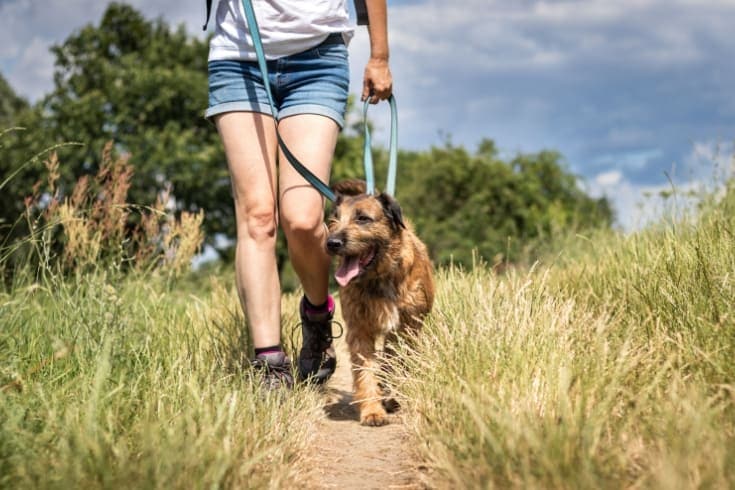
Begin walking as you usually do, holding your dog’s leash firmly. Wait for your dog to rush ahead and take up any slack in the loose leash.
Step 3 – “Heel!”
The moment your dog pulls, say “Heel!” loudly and firmly. Give the leash a gentle tug and immediately stand still. Your dog will eventually return to be by your side.
Step 4 – Reward
Reward your dog with plenty of verbal praise and give him a treat.
Your dog will quickly understand that by returning to your side, he’ll get a reward. The “heel” cue tells your pet he’s gone too far ahead and must turn back.
Practice Makes Perfect
No matter what leash training method you decide to use, the old maxim “practice makes perfect” applies.
With older dogs, it’s especially important to keep up with your training and remember to reward positive behavior whenever your dog does as you want. Although it could take weeks or even months of slow, disjointed walks, your old dog will soon learn the new trick of walking on a loose leash.
Once Fido is obedient and mannerly, you can reduce the number of treats you feed him.
FAQs
In this part of our guide, we answer some of the most commonly asked questions about leash training an adult dog.
Q: Can you leash-train an older dog?
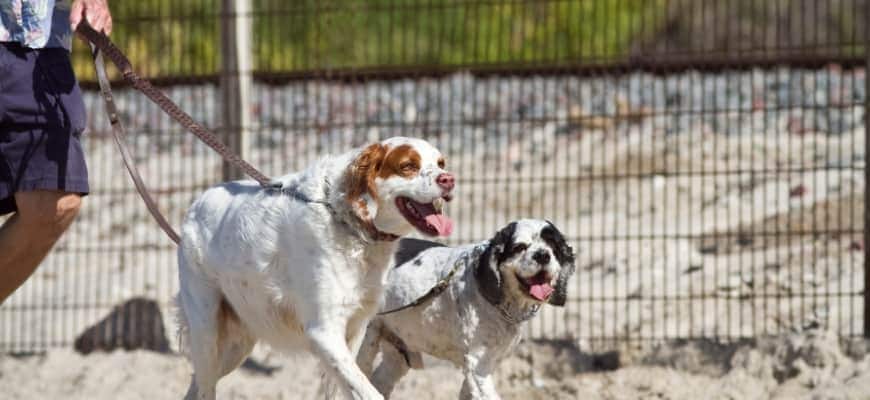
A: No dog owner wants to have a dog that pulls, lunges, or chews on the leash. Although it’s much better to train your dog early to prevent these problem behaviors from becoming established, it’s never too late to leash-train your pet.
Positive reinforcement and reward-based training methods are key to successfully training an older dog.
Q: Is it too late to train my dog off-leash?
A: It’s never too late to train your adult dog to enjoy exercising off-leash. In fact, there are several advantages to training adult dogs. Your dog won’t be as easily distracted or full of boundless energy as he was as a puppy.
Q: What age should a dog be leash trained?
A: Ideally, you want to start leash training a puppy when he’s eight weeks old. Your puppy should be fully leash-trained by the time he’s three months old.
Q: Can you train an older dog to walk without a leash?
A: Yes, you can train your older dog to walk without a leash. However, we recommend that you always keep your dog leashed in line with local leash laws in your area.
Final Thoughts
Did you enjoy our guide to leash training an adult dog? If you found the article helpful, please take a moment to share it!
If your older dog pulls, lunges, or jumps when on the leash, you can retrain him with patience and perseverance to walk alongside you on a loose leash. No matter what leash training method you use, we encourage you not to go down the punishment-based training route. That could make your dog resentful and afraid, which could permanently damage the bond between you.
How old was your dog when you leash-trained him? What leash training method did you use? Tell us about your pet in the comments box below.
